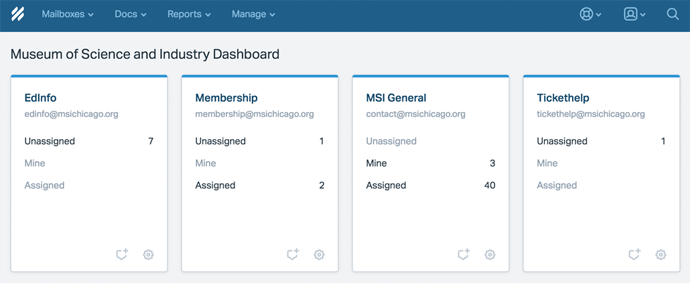By and large, nonprofit organizations depend on a different set of motivations to stay afloat than those in the private sector do.
Nonprofits are accountable to different sets of stakeholders, their relationships with whom can be more tenuous. Their “customers” are not only the recipients of their services, but the volunteers who give their time and the donors who give their money.
Just like the all-hands-on-deck approach in early-stage startups, customer service in nonprofits often isn’t a department so much as it is a function.
Among the nonprofits who “can truly claim customer service superiority,” writes Peggy Carlaw, “one thing is certain: Every employee owns a piece of that prize. Simply put, a non-profit cannot achieve customer service excellence without first attaining high levels of efficiency, quality, and productivity among its internal service providers.”
In fact, some nonprofits have embracing constraints down to such a science that their customer service rivals many of their for-profit counterparts.
So how do they do it? In part, by keeping tools and processes as simple as possible for everyone involved. Let’s look at a few case studies.
1. Saved replies help PetRescue save lives
Who they are: PetRescue is an Australian organization that helps find homes for thousands of abandoned and unwanted pets every month.
At the end of the day what we want to do is make sure that if somebody is looking to adopt a rescue pet, we want them to be able to do so. We don’t want to just leave people with no answer and make it too hard for them to adopt a pet that then they go off to a breeder and just buy one.
Who they serve: more than 950 animal rescue groups, shelters, and pounds in Australia, as well as people who wish to adopt pets.
The challenge: The general public doesn’t always understand what PetRescue does: PetRescue puts adopters in touch with rescue groups; they’re not a rescue group themselves. “We do not have 10,000 pets sitting in our office here,” says Laura Walker, PetRescue’s Website and Social Media Manager. “We have three dogs in the office at the moment, not 10,000.”
How they address it: As with many not-for-profit organizations where everyone wears multiple hats, the entire PetRescue team, from volunteers to the CEO, pitches in on customer support. They make heavy use of saved replies since, according to Walker, “the topic of discussion can be anything from ‘I haven't heard back about Fluffy,’ to ‘I want to start a fundraiser for you,’ to ‘I've found some stray cats.’ A lot of people are active in our mailbox and trying to do that through just one mailbox in Outlook just becomes so difficult, to keep track of who's dealing with what or what's been answered and what hasn't.”
2. The Museum of Science and Industry stays industrious with multiple mailboxes
Who they are: At 400,000+ square feet of exhibits, Chicago’s Museum of Science and Industry is one of the largest science museums in the world.
Who they serve: More than one million visitors each year.
The challenge: Not enough time and resources to tackle all the projects they’d like to be able to. “At a museum, there's always more to do and you just have to prioritize,” says Senior Communications Coordinator Angela Bradburn.
“We’re all stretched, doing many different projects at once. ... When you have people leave that know the answers to most of the questions, and know people that do stuff around the museum, it’s kind of hard to share that knowledge right away with someone else who’s really busy.”
DEFAULT
Angela Bradburn, Senior Communications Coordinator at the Museum of Science and Industry Chicago
How they address it: MSI chooses time-saving organizational tools and sets them up in such a way that no one person is the keeper of all knowledge — new teammates can search through tags or saved replies in the help desk, for example, to learn how similar conversations were handled in the past.

Rather than bounce around between multiple email inboxes, MSI manages all incoming messages from a single Help Scout account containing four mailboxes — education, membership, general, and ticket help.
3. Vote.org increases voter turnout by optimizing for efficiency
Who they are: Vote.org is a nonpartisan organization that removes barriers to voting and increases voter turnout.
Who they serve: Registered voters who need help with the voting process. “Every year there are millions of Americans who don’t vote because of some sort of roadblock,” says Vote.org founder Debra Cleaver. “They don’t know where their polling place is, or they need an absentee ballot and they don't know how to get it, or they don’t know what the voter ID requirements are. … When you contact us, you’re actually saying, ‘I want to vote, I just need help.’”
The challenge: Burning the candle at both ends.
The biggest challenge is that we’re moving really fast and when we stop to fundraise it means we’re not doing the work. ... How do we run programs 100 percent of the time and fundraise 100 percent of the time? You just need to get more efficient at everything.
DEFAULT
Vote.org founder Debra Cleaver
How they address it: Choosing tools to maximize efficiency. When voters can get their questions answered via the knowledge base versus sending an email, that saves the volunteers who staff the help desk precious time. Cleaver says that if she saves 10 minutes per day using a help desk rather than a shared Gmail or Outlook mailbox, “that’s 10 extra minutes I have to send follow up emails to potential funders.”
The challenges for nonprofit customer service
The need for efficiency isn’t exclusive to nonprofit organizations. At one point or another, we’ve all faced many of the same constraints at work — acquisition, retention, budgeting, attrition, turnover — to varying extremes.
The challenges for customer service are the same: making a case for quality customer support, for example.
What a headache it can be to juggle schedules, whether among a remote support team distributed across time zones, or part-time employees combined with a rotating cast of volunteers.
Or how difficult it is to target communications to different personas and stakeholders (e.g., investors, donors, customers, volunteers, employees, recipients) who have wildly divergent needs and interests.
When there’s no dedicated customer service department, support is everyone’s job. Choosing the right tools and maximizing for efficiency, then, are mission-critical efforts.







